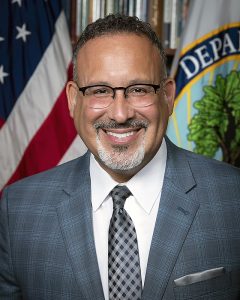WASHINGTON D.C., December 23, 2021 – Yesterday, the U.S. Department of Education announced a 90-day extension of the pause on student loan repayment, interest, and collections through May 1, 2022. Biden’s prior extension of the student loan payment pause was set to end on January 31, 2022.
According to the announcement, the extension will allow the Biden-Harris Administration time to assess the impacts of the Omicron variant and reduce the risk of defaults by borrowers.
The pause includes the following relief measures for eligible loans:
- A suspension of loan payments
- A 0% interest rate
- Suspension of collections on defaulted loans
Payments on most federal student loans have been suspended following Congress’s passage of the CARES Act in March 2020 which originally called for a six-month relief. Both presidents Donald J. Trump and Joe Biden have used executive authority to extend the repayments several times.

“Since Day One of this Administration, the Department has focused on supporting students and borrowers throughout the pandemic and ensuring they have the resources they need to return to repayment successfully,” said U.S. Secretary of Education Miguel Cardona. “This additional extension of the repayment pause will provide critical relief to borrowers who continue to face financial hardships as a result of the pandemic and will allow our Administration to assess the impacts of Omicron on student borrowers. As we prepare for the return to repayment in May, we will continue to provide tools and supports to borrowers so they can enter into the repayment plan that is responsive to their financial situation, such as an income-driven repayment plan. Students and borrowers will always be at the center of our work at the Department, and we are committed to not only ensuring a smooth return to repayment, but also increasing accountability and stronger customer service from our loan servicers as borrowers prepare for repayment.”
According to the Federal Reserve Bank of New York’s Center for Microeconomic Data press release, student loan balances increased $14 billion by the end of Q3 2021. The Dept. of Education states that the pause on student loan payments will help 41 million borrowers save $5 billion per month. Wednesday’s action is one of a series of steps the Biden-Harris Administration has taken to assist students and borrowers. These actions include:
- Revamping the Public Service Loan Forgiveness program in October, which has already provided $2.4 billion in loan relief to 38,000 borrowers. As part of that effort, the Department implemented a Limited PSLF Waiver to count all prior payments made by student borrowers toward PSLF, regardless of the loan program. Borrowers who are working in public service but have not yet applied for PSLF should do so before October 31, 2022, and can find out more at StudentAid.gov/PSLF.
- Providing $7.0 billion in relief for 401,000 borrowers who have a total and permanent disability.
- Approving $1.5 billion in borrower defense claims, including extending full relief to approved claims and approving new types of claims.
- Providing $1.26 billion in closed school discharges to 107,000 borrowers who attended the now-defunct ITT Technical Institute.
- Helping 30,000 small business owners with student loans seeking help from the Paycheck Protection Program.
More information can be found at StudentAid.gov.
Washington Congresswoman Pramila Jayapal (WA-07) called the pause on student debt “necessary” while Senator Elizabeth Warren (D-MA) called for the Biden-Harris Administration to #CancelStudentDebt.
I’m deeply grateful for everyone who joined this fight, called on the administration to extend the pause, and got this done. Raising your voice matters. It’s how we make change, and it’s how we’re going to take the next step to #CancelStudentDebt. https://t.co/6zj12vylTH
— Elizabeth Warren (@ewarren) December 22, 2021
It has been almost two years since President Biden promised some form of student loan forgiveness. While Biden campaigned on forgiving $10,000 in federal student loan debt for borrowers, he has yet to act.
Additionally, we should forgive a minimum of $10,000/person of federal student loans, as proposed by Senator Warren and colleagues. Young people and other student debt holders bore the brunt of the last crisis. It shouldn’t happen again.
— Joe Biden (@JoeBiden) March 22, 2020
Many activists, advocacy organizations, and Democrats in Congress have been urging President Biden to use executive action to cancel upwards of $50,000 in student loan debt for every borrower. So far, he has voiced opposition against such a move.
The total outstanding Federal Loan Portfolio on student loan debt is $1.59 trillion with the average borrower owing $39,351. Currently, the average public university student borrows $30,030 to attain a bachelor’s degree up from $17,000 when President Barack Obama announced his run for office in 2007.
Author: Mario Lotmore









